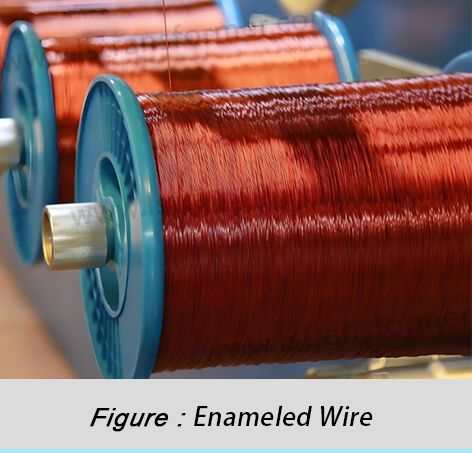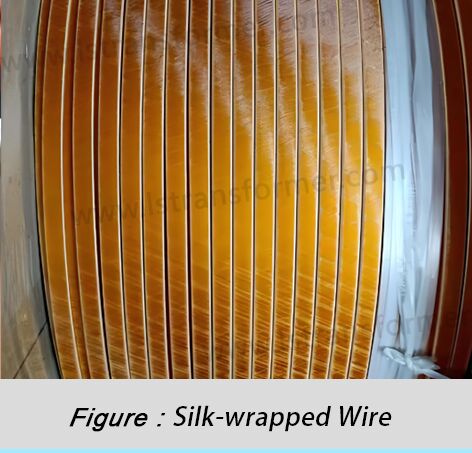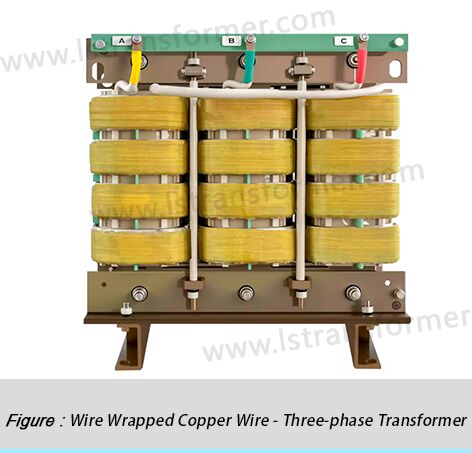Quelles sont les différences entre le fil recouvert de coton, le fil recouvert de soie, le fil isolé par film et le fil émaillé ?
Quelles sont les différences entre le fil recouvert de coton, le fil recouvert de soie, le fil isolé par film et le fil émaillé ?
Dans la fabrication d'équipements électriques tels que les transformateurs, les réacteurs et les moteurs, le traitement d'isolation des fils de bobinage est un facteur crucial pour la performance et la fiabilité du produit. Le fil recouvert de coton, le fil recouvert de soie, le fil isolé par film et le fil émaillé sont quatre types courants de conducteurs isolés, chacun se distinguant par ses matériaux isolants, ses procédés de fabrication, ses caractéristiques de performance et ses applications. Cet article propose une comparaison détaillée de ces quatre types de fils isolés afin de vous aider à faire le meilleur choix en fonction des exigences spécifiques de votre application.
1. Fil émaillé
Le fil émaillé est le type de fil isolé le plus utilisé dans la fabrication de transformateurs et de réacteurs. Il est obtenu en recouvrant des conducteurs en cuivre ou en aluminium de plusieurs couches de vernis isolant à haute teneur en polymère.
● Procédé de fabrication et propriétés des matériaux
La production de fil émaillé implique un procédé de « revêtement-cuisson », où le conducteur est soumis à plusieurs couches de vernis et à une cuisson à haute température. Parmi les vernis isolants courants, on trouve :
(1)Polyester :Offre une excellente résistance mécanique et à la chaleur (130°C).
(2)Polyuréthane :Facile à souder, souvent utilisé dans les applications haute fréquence.
(3)Polyimide:Résiste à des températures supérieures à 220°C.
(4)Polyamide-imide (fil AI) :Offre des performances équilibrées avec une résistance à la chaleur de 180°C.
La structure moléculaire du vernis isolant forme un réseau réticulé lors du durcissement à haute température, conférant au fil émaillé d'excellentes propriétés électriques et mécaniques. L'épaisseur du vernis varie généralement de 0.02 à 0.1 mm et peut être classée selon des normes internationales telles que la norme CEI 60317 ou la norme américaine NEMA MW 1000.
● Avantages en termes de performances et applications
Le fil émaillé excelle dans les domaines suivants :
(1)Haute efficacité spatiale :Le vernis fin et uniforme permet des enroulements compacts.
(2)Excellente rigidité diélectrique :Typiquement 5-10 kV/mm.
(3)Bonne stabilité thermique :Résiste au vieillissement à haute température.
(4) Flexibilité mécanique :Convient aux processus d'enroulement automatisés.
Ces propriétés font du fil émaillé le choix privilégié pour les transformateurs de petite et moyenne taille, les enroulements de moteurs et les composants inductifs, en particulier dans les applications à haute densité de puissance où l'espace est limité.
● Comparaison des paramètres techniques
Le tableau ci-dessous présente les paramètres clés des fils émaillés courants :
Type | Cote de température | Tension de claquage | Applications typiques | Norme de conformité |
Polyester émaillé | 130 ° C | ≥ 5 kV/mm | Transformateurs généraux | IEC 60317-13 |
Émaillé en polyuréthane | 120 ° C | ≥ 3 kV/mm | Bobines haute fréquence | IEC 60317-20 |
Polyimide émaillé | 220 ° C | ≥ 7 kV/mm | Environnements à haute température | NEMA MW 35C |
Composite émaillé | 180 ° C | ≥ 6 kV/mm | Moteurs à fréquence variable | IEC 60317-56 |
2. Fil recouvert de coton
Le fil recouvert de coton est un fil isolé traditionnel qui utilise du fil de coton ou de fibre synthétique enroulé autour du conducteur comme isolant.
● Structure et processus de fabrication
Le fil gainé de coton est produit par un procédé de « guidage », où le fil est enroulé en spirale autour du conducteur selon un angle et une tension spécifiques. Plusieurs couches sont généralement appliquées pour obtenir une épaisseur d'isolation suffisante (0.2 à 0.5 mm). Pour améliorer les performances d'isolation, le fil est souvent imprégné d'huile ou de résine isolante.
Les performances d'isolation du fil recouvert de coton dépendent de :
(1)Le fil»ses propriétés isolantes inhérentes.
(2)Densité et uniformité de l'emballage.
(3) La performance du matériau d’imprégnation.
● Caractéristiques et limitations
(1) Avantages du fil recouvert de coton
Le fil gainé de coton présente une excellente résistance à l'effet couronne. Sa structure fibreuse répartit uniformément les champs électriques, réduisant ainsi les décharges partielles et augmentant la tension d'amorçage de l'effet couronne de 30 à 50 % par rapport à un fil émaillé de même épaisseur. Il est donc idéal pour les environnements haute fréquence et haute tension.
De plus, sa structure poreuse assure une dissipation thermique supérieure, abaissant les températures d'enroulement de 15 à 20 °C grâce à une convection d'air améliorée, ce qui la rend adaptée aux équipements à haute densité de puissance.
L'épaisse couche de fil offre également une protection mécanique robuste, amortissant efficacement les vibrations et les impacts. Même partiellement endommagé, l'isolant ne se détériore pas immédiatement, ce qui en fait un choix sûr pour les environnements soumis à de fortes vibrations, comme les engins miniers et le transport ferroviaire.
(2) Inconvénients du fil recouvert de coton
Le principal inconvénient est le faible encombrement. L'isolation épaisse augmente le diamètre du fil de 50 à 100 % par rapport au fil émaillé, ce qui se traduit par un facteur de remplissage de l'enroulement de seulement 0.3 à 0.5, augmentant ainsi considérablement la taille et le poids de l'appareil.
L'absorption d'humidité constitue un autre problème. À 60 % d'humidité, la résistance de l'isolant peut être divisée par dix, ce qui entraîne à terme une hydrolyse des fibres et la formation de moisissures, nécessitant des traitements d'imprégnation supplémentaires. La fabrication est également plus lente, avec des vitesses d'emballage inférieures à 50 m/min et une automatisation limitée, ce qui augmente les coûts de main-d'œuvre. La complexité des manipulations des joints réduit encore davantage l'efficacité de la production.
Ces limitations limitent le fil recouvert de coton à des applications de niche, telles que les réparations électriques anciennes et les équipements de test haute tension.
3. Fil recouvert de soie
Le fil recouvert de soie est similaire au fil recouvert de coton, mais utilise des fibres de soie naturelles ou synthétiques pour l'isolation, principalement dans les appareils électroniques de haute précision et de haute fréquence.
● Propriétés des matériaux et processus de fabrication
Le fil gainé de soie est composé de soie fine (naturelle ou synthétique, par exemple, aramide) gainée à haute densité, avec une épaisseur d'isolation généralement comprise entre 0.1 et 0.3 mm. Pour améliorer les performances, les traitements suivants sont souvent appliqués :
(1)Dégraissage :Élimine les impuretés des fibres de soie.
(2) Imprégnation :Utilise des résines spéciales pour améliorer l'isolation.
(3)Revêtement de surface :Ajoute des couches protectrices contre les dommages mécaniques.
La structure microfibreuse de la soie crée de minuscules espaces d'air uniformément répartis, conférant au fil des propriétés diélectriques uniques.
● Performances et applications haute fréquence
Le fil recouvert de soie excelle dans les applications haute fréquence grâce à :
(1)Faible perte diélectrique (tanδ<0.01).
(2)Permittivité stable sur toutes les fréquences.
(3) Contrôle précis de la capacité via la densité d'emballage.
Ces propriétés rendent le fil recouvert de soie idéal pour les transformateurs haute fréquence, les bobines RF et les appareils de mesure de précision, en particulier lorsque les paramètres parasites doivent être étroitement contrôlés.
4. Fil isolé par film
Le fil isolé par film utilise des films polymères (par exemple, polyester, polyimide) enroulés ou extrudés autour du conducteur, offrant une solution haute performance pour les équipements électriques modernes.
● Matériaux du film et conception structurelle
Les matériaux de film courants comprennent :
(1)Film PET : 12-50μm d'épaisseur, économique.
(2)Film PI : Résiste à des températures supérieures à 250°C.
(3)Film PTFE : Excellente résistance chimique et faible frottement.
La structure d’isolation comprend généralement :
(1) Blindage intérieur (en option).
(2) Film isolant principal (couche simple ou multiple).
(3)Couche protectrice extérieure (anti-rayures).
La tension de claquage théorique peut être calculée comme :
V_bd = E_bd × d × K
Où :
V_bd : Tension de claquage (kV).
E_bd : Rigidité diélectrique du matériau (MV/m).
d : Épaisseur totale de l'isolation (mm).
K : Coefficient de structure (0.7-0.9, en tenant compte des effets d'interface).
● Avantages et applications
Les hautes performances du fil isolé par film proviennent de sa structure de film de précision. Grâce à des polymères à alignement moléculaire et à un contrôle d'épaisseur de ± 1 μm, sa rigidité diélectrique atteint 15 kV/mm, soit trois fois celle du fil émaillé. Des traitements spéciaux, comme le prétraitement plasma et le nano-interfaçage (par exemple, le dopage SiO₂), améliorent encore l'adhérence et la résistance à la chaleur.
Les conceptions multifonctionnelles intègrent des couches conductrices, isolantes et protectrices, tandis que les nanocharges (par exemple, Al₂O₃) améliorent la conductivité thermique. Ceci permet :
(1) Les moteurs d'entraînement automobiles doivent durer 200°C et plus de 100 000 heures de résistance à la couronne.
(2)Systèmes d'alimentation aérospatiaux pour fonctionner à des températures extrêmes (-65°C 260°C) avec certification NASA.
(3)Transformateurs de station de base 5G pour atteindre une permittivité ultra-faible (εr = 2.3) et la perte (tanδ< 0.001), minimisant l'atténuation du signal.
5. Guide complet de comparaison et de sélection
Pour aider les ingénieurs à choisir le bon fil isolé, le tableau ci-dessous compare les paramètres clés :
Propriété | Fil émaillé | Fil recouvert de coton | Fil recouvert de soie | Fil isolé par film |
Épaisseur d'isolation | 0.02 – 0.1 mm | 0.2 – 0.5 mm | 0.1 – 0.3 mm | 0.05 – 0.2 mm |
Max Température | 220 ° C | 105 ° C | 150 ° C | 250 ° C |
Résistance diélectrique | 5–10 kV/mm | 3–6 kV/mm | 4–8 kV/mm | 10–15 kV/mm |
Perte diélectrique | Moyenne | Haute | Faible | Très Bas |
Indice des coûts | 1.0 | 1.5 | 3.0 | 2.0-5.0 |
En résumé
Les fils recouverts de coton, de soie, de film et émaillés présentent chacun des propriétés et des applications uniques. Le fil émaillé, avec son équilibre entre performances et rentabilité, reste le choix privilégié pour la plupart des applications de transformateurs et de réacteurs. Les fils recouverts de coton et de soie conservent leur valeur dans les domaines spécialisés, tandis que le fil filmé excelle dans les applications haute température, haute fréquence et haute fiabilité.
Progrès dans la science des matériaux et la fabrication-tels que l'isolation composite et les matériaux nano-modifiés-sont à l'origine de l'innovation dans la technologie des fils de bobinage. Les ingénieurs doivent tenir compte des exigences électriques, thermiques et mécaniques, ainsi que du coût, lors du choix des fils isolés, tout en se tenant informés des normes internationales afin de garantir des conceptions électromagnétiques performantes et fiables.
Contactez-Nous
LuShan, HNE.1975, est un fabricant chinois spécialisé dans les transformateurs et réacteurs de puissance depuis plus de 50 ans. Ses principaux produits sont :Transformateur monophasé, transformateurs d'isolement triphasés, transformateur électrique, transformateur de distribution, transformateur abaisseur et élévateur, transformateur basse tension, transformateur haute tension, transformateur de contrôle, transformateur toroïdal, transformateur à noyau R ; inductances CC, réacteurs CA, réacteur de filtrage, réacteur de ligne et de charge, selfs, réacteur de filtrage et produits intermédiaires à haute fréquence.
Nos transformateurs et réacteurs de puissance sont largement utilisés dans 10 domaines d'application : transport rapide, engins de chantier, énergie renouvelable, fabrication intelligente, équipement médical, prévention des explosions de mines de charbon, système d'excitation, frittage sous vide (four), climatisation centrale.
En savoir plus sur le transformateur de puissance et le réacteur :www.lstransformer.com.
Si vous souhaitez obtenir des solutions personnalisées pour les transformateurs ou les réacteurs, veuillez nous contacter.
WhatsApp:+86 17267488565
Courriel : marketing@hnlsdz.com

 EN
EN
 FR
FR DE
DE ES
ES



